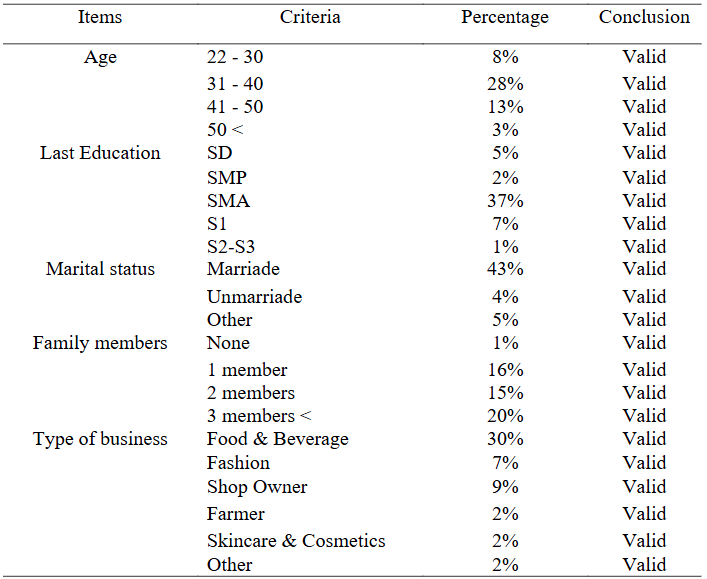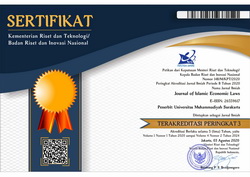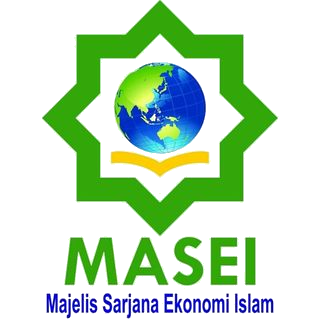How Does the Performance of Islamic Microfinance Institutions Affect the Welfare of SMEs?: Empirical study of BTM Mulia Babat
DOI:
https://doi.org/10.23917/jisel.v7i02.6148Keywords:
Islamic microfinance, Baitul Tamwil Muhammadiyah, SMEs welfareAbstract
This study aims to assess the direct and indirect effectiveness of Islamic microfinance services, particularly financing products, in enhancing the welfare of small and medium-sized entrepreneurs (SMEs) in Lamongan, with Baitul Tamwil Muhammadiyah (BTM) Mulia Babat as the case study. The partial least square-structural equation modeling method is used in this quantitative study, examining data from 52 respondents, where the respondent data are BTM Mulia Babat business financing customers. The findings of this study found that Islamic microfinance services and business assistance directly have a positive impact on SMEs' increase in income. However, Islamic microfinance services and business assistance indirectly do not impact SMEs' welfare. Despite the increase in SMEs' income, it directly impacts SMEs' welfare. The novelty of this study is to identify the effectiveness of Islamic microfinance institutions in improving the welfare of SMEs. This study presents evidence of the impact of Islamic microfinance institutions on the welfare of micro and medium entrepreneurs. It can encourage more Islamic microfinance programs to offer feasible Islamic microfinance services as an alternative to boosting SMEs in the regions. This study's empirical implications and findings highlight the importance of business assistance from Islamic MIFs as business financing providers to support businesses.
Downloads
References
Ab Hamid, M. R., Sami, W., & Mohmad Sidek, M. H. (2017). Discriminant Validity Assessment: Use of Fornell & Larcker criterion versus HTMT Criterion. Journal of Physics: Conference Series, 890(1), 0–5. https://doi.org/10.1088/1742-6596/890/1/012163
Abdillah, W., & Jogiyanto. (2016). Partial Least Square (PLS) Alternantif Structural Equation Modeling (SEM) dalam Penelitian Bisnis. ANDI.
Ahmad, S., Siddiqui, K. A., & AboAlsamh, H. M. (2020). Family SMEs’ Survival: The Role of Owner Family and Corporate Social Responsibility. Journal of Small Business and Enterprise Development, 27(2), 281–297. https://doi.org/10.1108/JSBED-12-2019-0406
Al-Mamun, A., & Mazumder, M. N. H. (2015). Impact of Microcredit on Income, Poverty, and Economic Vulnerability In Peninsular Malaysia. Development in Practice, 25(3), 333–346. https://doi.org/10.1080/09614524.2015.1019339
Al-Shami, S. S. A., Razali, M. M., Majid, I., Rozelan, A., & Rashid, N. (2016). The Effect of Microfinance on Women’s Empowerment: Evidence from Malaysia. Asian Journal of Women’s Studies, 22(3), 318–337. https://doi.org/10.1080/12259276.2016.1205378
Ali, I., Hatta, Z. A., Azman, A., & Islam, S. (2017). Microfinance as a Development and Poverty Alleviation Tool in Rural Bangladesh: A Critical Assessment. Asian Social Work and Policy Review, 11(1), 4–15. https://doi.org/10.1111/aswp.12106
Arif, I. (2023). BTM Mulia Hadir di Musycab Paciran. PWMU.Co - PT. Surya Media Jatim. https://pwmu.co/304064/07/10/btm-mulia-hadir-di-musycab-paciran/
Arifin, R., Ningsih, A. A. T., & Putri, A. K. (2021). The Important Role of MSMEs in Improving The Economy. South East Asia Journal of Contemporary Business, Economics and Law, 24(6), 52–59.
Aristina, P., & Widiastuti, T. (2020). Peran Penyaluran Dana Pihak Ketiga Bmt Muda Jatim Pada Peningkatan Kesejahterraan Pelaku Umkm Perspektif Maqashid Syariah. Jurnal Ekonomi Syariah Teori Dan Terapan, 6(11), 2198. https://doi.org/10.20473/vol6iss201911pp2198-2215
As-Salafiyah, A., & Ratna Kartikawati, D. (2022). Islamic Microfinance as Social Finance in Indonesia. Islamic Social Finance, 2(1). https://doi.org/10.58968/isf.v2i1.118
Badan Pusat Statistik. (2022a). Jumlah Koperasi Aktif Menurut Provinsi (Unit), 2019-2021. https://www.bps.go.id/indicator/13/760/1/jumlah-koperasi-aktif-menurut-provinsi.html
Badan Pusat Statistik. (2022b). Profil Kemiskinan di Indonesia September 2022. Berita Resmi Statistik, 01(05), 1–8.
Chapra, M. U. (1985). Towards a Just Monetary System (Vol. 8). International Institute of Islamic Thought (IIIT).
Databoks. (2023). Jumlah UMKM di Indonesia Sepanjang 2022, Provinsi Mana Terbanyak? Databoks.Katadata.Co.Id. https://databoks.katadata.co.id/datapublish/2023/02/02/jumlah-umkm-di-indonesia-sepanjang-2022-provinsi-mana-terbanyak#:~:text=Ini terlihat dari data yang,Pulau Jawa mendominasi sektor ini.
Elsafi, M. H., Ahmed, E. M., & Ramanathan, S. (2020). The Impact of Microfinance Programs on Monetary Poverty Reduction: Evidence from Sudan. World Journal of Entrepreneurship, Management and Sustainable Development, 16(1), 30–43. https://doi.org/10.1108/WJEMSD-05-2019-0036
Fadhilah, E., Purwanto, M. R., Mukharrom, T., Dewantoro, M. H., & Supriadi. (2020). A Perspective of Maqasid Al-Syariah Towards Women’s Particular Needs in Disaster. International Journal of Advanced Science and Technology, 29(2), 2070–2075.
Fianto, B. A., Gan, C., Hu, B., & Roudaki, J. (2018). Equity Financing and Debt-Based Financing: Evidence from Islamic Microfinance Institutions in Indonesia. Pacific Basin Finance Journal, 52(July), 163–172. https://doi.org/10.1016/j.pacfin.2017.09.010
Fornell, C., & f. larcke, D. (1981). Fornell, C., & Larcker, D. F. (1981). Evaluating Structural Equation Models with Unobservable Variables and Measurement Error. Journal of Marketing Research, 18(1), 39–50.
Friedlander, W. (1980). Pengantar Kesejahteraan Sosial. Gema Insani Press.
Gebru, B., & Paul, I. (2011). Role of Micro Finance in Alleviating Urban Poverty in Ethiopia. Journal of Sustainable Development in Africa, 13(6), 246–257.
Ghozali, I. (2008). Structural Equation Modeling: Teori, Konsep, dan Aplikasi.
Ghozali, I. (2014). Structural Equation Modelling, Edisi II. Universitas Semarang.
Gina, W., & Effendi, J. (2015). Program Pembiayaan Lembaga Keuangan Mikro Syariah (LKMS) dalam Peningkatan Kesejahteraan Pelaku Usaha Mikro (Studi Kasus BMT Baitul Karim Bekasi). Al-Muzara’ah, 3(1), 34–43. https://doi.org/10.29244/jam.3.1.34-43
Ginanjar, A., & Kassim, S. (2020). Can Islamic Microfinance Alleviates Poverty in Indonesia? an Investigation From the Perspective of the Microfinance Institutions. Journal of Islamic Monetary Economics and Finance, 6(1), 77–94. https://doi.org/10.21098/jimf.v6i1.1203
Hadisumarto, W. bin M. C., & B. Ismail, A. G. B. (2010). Improving the Effectiveness of Islamic Micro-Financing: Learning from BMT Experience. Humanomics, 26(1), 65–75. https://doi.org/10.1108/08288661011025002
Hair, J. F., Ringle, G. T. M., & Sarstedt, C. M. (2014). A Primer On Partial Least Squares Structural Equation Modeling (PLS-SEM). SAGE Publications.
Hair, J. F., Black, W. C., Babin, B. J., Anderson, R. E., & Tatham, R. L. (2010). Cluster Analysis. Multivariate Data Analysis. In Hair JF (Ed.), Volume 7th ed. Pearson Education.
Hair, J., Hollingsworth, C. L., Randolph, A. B., & Chong, A. Y. L. (2017). An Updated and Expanded Assessment of PLS-SEM in Information Systems Research. Industrial Management and Data Systems, 117(3), 442–458. https://doi.org/10.1108/IMDS-04-2016-0130
Hair, Joe F., Ringle, C. M., & Sarstedt, M. (2011). PLS-SEM: Indeed a Silver Bullet. Journal of Marketing Theory and Practice, 19(2), 139–152. https://doi.org/10.2753/MTP1069-6679190202
Hair, Joe F., Sarstedt, M., Ringle, C. M., & Mena, J. A. (2012). An Assessment of the Use of Partial Least Squares Structural Equation Modeling in Marketing Research. Journal of the Academy of Marketing Science, 40(3), 414–433. https://doi.org/10.1007/s11747-011-0261-6
Hair, Joseph F., Risher, J. J., Sarstedt, M., & Ringle, C. M. (2019). When to Use and How to Report the Results of PLS-SEM. In European Business Review. https://doi.org/10.1108/EBR-11-2018-0203
Hair, Joseph F., Sarstedt, M., & Ringle, C. M. (2019). Rethinking Some of the Rethinking of Partial Least Squares. European Journal of Marketing, 53(4), 566–584. https://doi.org/10.1108/EJM-10-2018-0665
Hair Jr, J. F., Hult, G. T. M., Ringle, C. M., & & Sarstedt, M. (2021). A Primer on Partial Least Squares Structural Equation Modeling (PLS-SEM). Sage publications.
Hamdan, H., Othman, P., Sabri, W., & Hussin, W. (2012). Is Microfinance Program in Malaysia Really Effective in Helping the Poor ? World Review of Business Research, 2(1), 79–97. http://www.wbiaus.org/6. Hamdino.pdf
Harahap, I., Nawawi, Z. M., & Syahputra, A. (2023). Signifikansi Peranan UMKM dalam Pembangunan Ekonomi di Kota Medan dalam Prespektif Syariah. Jurnal Tabarru’ : Islamic Banking and Finance, 6(2), 718–728.
Henseler, J., Ringle, C. M., & Sarstedt, M. (2015). A New Criterion for Assessing Discriminant Validity in Variance-Based Structural Equation Modeling. Journal of the Academy of Marketing Science, 43(1), 115–135. https://doi.org/10.1007/s11747-014-0403-8
Ibrahim, D., & RuziahGhazali, D. (2014). Zakah as an Islamic Micro-Financing Mechanism to Productive Zakah Recipients. Asian Economic and Financial Review, 4(1), 117-125., 4(1), 117–125. http://www.pakinsight.com/pdf-files/aefr 4(1), 117-125.pdf
KEMENKOMUKM.RI. (2023). Data Lembaga Koperasi di Kementerian Koperasi dan Usaha Kecil dan Menengah Republik Indonesia (KEMENKOPUKM RI). KEMENKOPUKM RO. http://nik.depkop.go.id/
KEMENKOPUKM.RI. (2022). Satu Data KUMKM Terintegrasi. Kementerian Koperasi dan UKM. https://satudata.kemenkopukm.go.id/
Kireti, G. W., & Sakwa, M. (2014). Socio-Economic Effects of Microfinance Services on Women: The Case of Rosewo Microfinance, Nakuru County, Kenya. International Journal of Academic Research in Economics and Management Sciences, 3(3), 43–59. https://doi.org/10.6007/ijarems/v3-i3/902
KSPPS BTM MULIA BABAT. (2021). Laporan Pertanggung Jawaban Pengurus dan Pengawas Rapat Anggota Tahunan (RAT) Tahun 2021.
Kusuma, K. A., & Ryandono, M. N. H. (2016). Zakah Index: Islamic Economics’ Welfare Measurement. Indonesian Journal of Islam and Muslim Societies, 6(2), 273–301. https://doi.org/10.18326/ijims.v6i1.273-301
Loke, K. H., Adebola, S. S., Ramasamy, S., & Dahalan, J. (2020). The Effects of Services by Microfinance Institutions on the Welfare of Urban Households in Malaysia. Jurnal Pengurusan, 58, 105–118. https://doi.org/10.17576/pengurusan-2020-58-09
Malhotra, N. K. (2009). Riset Pemasaran, Edisi keempat, Jilid 1. Jakarta: PT Indeks. https://doi.org/10.1163/_q3_SIM_00374
Maulana, H., & Umam, K. (2018). Identifying Financial Exclusion and Islamic Microfinance as An Alternative to Enhance Financial Inclusion. International Journal of Islamic Business and Economics (IJIBEC), 99–106. https://doi.org/10.28918/ijibec.v1i2.1004
Maulidia, S., & Nur, M. (2022). Syariah Microfinance Institutions and Women-Based MSME Empowerment in an Efforts to Reducing Poverty (Study at KSPPS Baytul Ikhtiar Bogor). FOCUS Journal of Social Studies, 3(1), 27–47.
Mawardi, I., Widiastuti, T., Al Mustofa, M. U., & Hakimi, F. (2022). Analyzing the Impact of Productive Zakat on the Welfare of Zakat Recipients. Journal of Islamic Accounting and Business Research. https://doi.org/10.1108/JIABR-05-2021-0145
Memon, M. A., Ting, H., Ramayah, T., Chuah, F., & Cheah, J.-H. (2017). A Review of the Methodological Misconceptions and Guidelines Related to the Application of Structural Equation Modeling: a Malaysian Scenario. Journal of Applied Structural Equation Modeling, 1(June), i–xiii. https://doi.org/10.47263/jasem.1(1)01
Mohammad A. Asharaf. (2010). The Effectiveness of Microcredit Programs and Prospects of Islamic Microfinance Institutes ( IMFIs ) in Muslim Countries : A Case Study in Bangladesh. Journal of Islamic Economics, Banking and Finance, 6(604), 69–85. http://ibtra.com/pdf/journal/v6_n4_article4.pdf
Mohd Thas Thaker, M. A. Bin, Kassim, S., Amin, M. F. Bin, Salleh, M. C. M., Othman, N., & Kassim, S. N. (2022). Modeling the Demand for Islamic Microfinance Services: An Application of PLS-SEM Approach. International Journal of Islamic Economics and Finance (IJIEF), 5(1), 89–106. https://doi.org/10.18196/ijief.v5i1.11776
Nawaz, S., Sheikh, M. R., & Zahra, K. A. (2021). Islamic Microfinance and Women Entrepreneurship Performance during COVID-19 Pandemic. Journal of Accounting and Finance in Emerging Economies, 7(3), 727–738. https://doi.org/10.26710/jafee.v7i3.1943
OJK. (2021). Laporan Perkembangan Keuangan Syariah Indonesia 2021. Ketahanan Dan Daya Saing Keuangan Syariah, 148. https://www.ojk.go.id/id/kanal/syariah/data-dan-statistik/laporan-perkembangan-keuangan-syariah-indonesia/Pages/Laporan-Perkembangan-Keuangan-Syariah-Indonesia-2020.aspx
Purwanti, A. (2024). Manajer BTM Mulia Babat. Informant.
Purwanto, P., Abdullah, I., Ghofur, A., Abdullah, S., & Elizabeth, M. Z. (2022). Adoption of Islamic Microfinance in Indonesia an Empirical Investigation: An Extension of the Theory of Planned Behaviour. Cogent Business and Management, 9(1). https://doi.org/10.1080/23311975.2022.2087466
Putu Ayu Sita Laksmi, & I Gde Wedana Arjawa. (2023). Peran Pemerintah dan Modal Sosial dalam Meningkatkan Kesejahteraan Pelaku Usaha. JOURNAL SCIENTIFIC OF MANDALIKA (JSM) e-ISSN 2745-5955 | p-ISSN 2809-0543, 4(3), 12–21. https://doi.org/10.36312/10.36312/vol4iss3pp12-21
Rahayu, N. S. (2020). The Intersection of Islamic Microfinance and Women’s Empowerment: A Case Study of Baitul Maal Wat Tamwil in Indonesia. International Journal of Financial Studies, 8(2), 1–13. https://doi.org/10.3390/ijfs8020037
Rahman, F. K., Tareq, M. A., Yunanda, R. A., & Mahdzir, A. (2017). Maqashid Al-Shari’ah-Based Performance Measurement for the Halal Industry. Humanomics, 33(3), 357–370.
Rohman, P. S., Fianto, B. A., Ali Shah, S. A., Kayani, U. N., Suprayogi, N., & Supriani, I. (2021). A Review on Literature of Islamic Microfinance from 2010-2020: Lesson for Practitioners and Future Directions. Heliyon, 7(12), e08549. https://doi.org/10.1016/j.heliyon.2021.e08549
Rokhman, W., & Abduh, M. (2020). Antecedents of Smes’ Satisfaction and Loyalty Towards Islamic Microfinance: Evidence from Central Java, Indonesia. Journal of Islamic Marketing, 11(6), 1327–1338. https://doi.org/10.1108/JIMA-05-2018-0090
Santoso, D. B., Gan, C., Revindo, M. D., & Massie, N. W. G. (2020). The Impact of Microfinance on Indonesian Rural Households’ Welfare. Agricultural Finance Review, 80(4), 491–506. https://doi.org/10.1108/AFR-11-2018-0098
Sekaran, U. and Bougie, R. (2013). Research Methods for Business (Sons, J. Wiley, & Atrium (eds.); 6th ed.). Southern Gate, Chichester, West Sussex.
Sinkovics, R. R., Jean, R.-J. B., & Kim, D. (2016). Advancing the International Marketing Research Agenda with Innovative Methodologies – An Introduction. International Marketing Review. https://doi.org/10.1108/IMR-03-2016-0071
Suharti, F. (2018). SINERGITAS ISLAMIC MICROFINANCE INSTITUTION (IMFI): Pemberdayaan dan Peningkatan Kesejahteraan Usaha Mikro Kecil dan Menengah (UMKM). El-Jizya : Jurnal Ekonomi Islam, 5(1), 52–80. https://doi.org/10.24090/ej.v5i1.1626
Taufiq, M. (2020). Optimalisasi Peran Dewan Pengawas Syariah di Lembaga Keuangan Mikro Syariah. Al-Huquq: Journal of Indonesian Islamic Economic Law, 2(1), 74. https://doi.org/10.19105/alhuquq.v2i1.3350
Uddin, H., & Barai, M. K. (2016). Islamic Microcredit: The Case of Bangladesh. Journal of Accounting, Finance and Economics, 6(1), 49–64.
Ülev, S., Savaşan, F., & Özdemir, M. (2022). Do Islamic Microfinance Institutions Affect the Socio-Economic Development of the Beneficiaries? The Evidence from Turkey. International Journal of Ethics and Systems. https://doi.org/https://doi.org/10.1108/IJOES-09-2021-0179
Wibowo, K. A., Ismail, A. G., Tohirin, A., & Sriyana, J. (2020). Factors Determining Intention to Use Banking Technology in Indonesian Islamic Microfinance. Journal of Asian Finance, Economics and Business. Vol. 7 (12), 1053–1064. https://doi.org/10.13106/jafeb.2020.vol7.no12.1053
Widiastuti, T., Auwalin, I., Rani, L. N., & Ubaidillah Al Mustofa, M. (2021). A Mediating Effect of Business Growth on Zakat Empowerment Program and Mustahiq’s Welfare. Cogent Business and Management, 8(1). https://doi.org/10.1080/23311975.2021.1882039
Wulandari, P., & Kassim, S. (2016). Issues and Challenges in Financing the Poor: Case of Baitul Maal Wa Tamwil in Indonesia. International Journal of Bank Marketing, 34(2), 216–234. https://doi.org/10.1108/IJBM-01-2015-0007
Zitouni, T., & Ben Jedidia, K. (2022). Does Islamic Microfinance Contribute to Economic Empowerment in Tunisia?: A Case Study Of Zitouna Tamkeen. Journal of Business and Socio-Economic Development, 2(1), 67–81. https://doi.org/10.1108/jbsed-10-2021-0143

Submitted
Accepted
Published
How to Cite
Issue
Section
License
Copyright (c) 2024 Journal of Islamic Economic Laws

This work is licensed under a Creative Commons Attribution-ShareAlike 4.0 International License.



















